Bosch PS50 User Manual

BM 2609140575 07-08 7/8/08 3:54 PM Page 1
IMPORTANT: |
IMPORTANT : |
IMPORTANTE: |
Read Before Using |
Lire avant usage |
Leer antes de usar |
Operating/Safety Instructions 
 Consignes de fonctionnement/sécurité
Consignes de fonctionnement/sécurité
Instrucciones de funcionamiento y seguridad
PS50
Call Toll Free for |
Pour obtenir des informations |
Llame gratis para |
Consumer Information |
et les adresses de nos centres |
obtener información |
& Service Locations |
de service après-vente, |
para el consumidor y |
|
appelez ce numéro gratuit |
ubicaciones de servicio |
1-877-BOSCH99 (1-877-267-2499) www.boschtools.com
For English Version |
Version française |
Versión en español |
See page 2 |
Voir page 15 |
Ver la página 28 |
|
|
|

BM 2609140575 07-08 7/8/08 3:54 PM Page 2
|
General Power Tool Safety Warnings |
|
|
Read all safety warnings and instructions. Failure to follow the warnings |
|
! WARNING |
||
|
and instructions may result in electric shock, fire and/or serious injury. |
|
|
||
|
SAVE ALL WARNINGS AND INSTRUCTIONS |
|
|
FOR FUTURE REFERENCE |
|
The term “power tool” in all of the warnings listed below refers to your mains-operated (corded) power tool or battery-operated (cordless) power tool.
Work area safety
Keep work area clean and well lit. Cluttered or dark areas invite accidents.
Do not operate power tools in explosive atmospheres, such as in the presence of flammable liquids, gases or dust. Power tools create sparks which may ignite the dust or fumes.
Keep children and bystanders away while operating a power tool. Distractions can cause you to lose control.
Electrical safety
Power tool plugs must match the outlet. Never modify the plug in any way. Do not use any adapter plugs with earthed (grounded) power tools. Unmodified plugs and matching outlets will reduce risk of electric shock.
Avoid body contact with earthed or grounded surfaces such as pipes, radiators, ranges and refrigerators. There is an increased risk of electric shock if your body is earthed or grounded.
Do not expose power tools to rain or wet conditions. Water entering a power tool will increase the risk of electric shock.
Do not abuse the cord. Never use the cord for carrying, pulling or unplugging the power tool. Keep cord away from heat, oil, sharp edges or moving parts. Damaged or entangled cords increase the risk of electric shock.
When operating a power tool outdoors, use an extension cord suitable for outdoor use. Use of a cord suitable for outdoor use reduces the risk of electric shock.
If operating the power tool in damp locations is unavoidable use a Ground Fault Circuit Interrupter (GFCI) protected supply. Use of a GFCI reduce the risk of electric shock.
GFCI and personal protection devices like electrician’s rubber gloves and footwear will further enhance your personal safety.
Do not use AC only rated tools with a DC power supply. While the tool may appear to work, the electrical components of the AC rated tool are likely to fail and create a hazard to the operator.
Personal safety
Stay alert, watch what you are doing and use common sense when operating a power tool. Do not use a power tool while you are tired or under the influence of drugs, alcohol or medication. A moment of inattention while operating power tools may result in serious personal injury.
Use personal protective equipment. Always wear eye protection. Protective equipment such as dust mask, non-skid safety shoes, hard hat, or hearing protection used for appropriate conditions will reduce personal injuries.
Prevent unintentional starting. Ensure the switch is in the off-position before connecting to power source and / or battery pack, picking up or carrying the tool. Carrying power tools with your finger on the switch or plugging in power tools that have the switch on invites accidents.
Remove any adjusting key or wrench before turning the power tool on. A wrench or a key left attached to a rotating part of the power tool may result in personal injury.
Do not overreach. Keep proper footing and balance at all times. This enables better control of the power tool in unexpected situations.
Dress properly. Do not wear loose clothing or jewelry. Keep your hair, clothing and gloves away from moving parts. Loose clothes, jewelry or long hair can be caught in moving parts.
If devices are provided for the connection of dust extraction and collection facilities, ensure these are connected and properly used. Use of dust collection can reduce dustrelated hazards.
-2-

BM 2609140575 07-08 7/8/08 3:54 PM Page 3
Keep handles dry, clean and free from oil and grease. Slippery hands cannot safely control the power tool.
Power tool use and care
Do not force the power tool. Use the correct power tool for your application. The correct power tool will do the job better and safer at the rate for which it was designed.
Do not use the power tool if the switch does not turn it on and off. Any power tool that cannot be controlled with the switch is dangerous and must be repaired.
Disconnect the plug from the power source and/or the battery pack from the power tool before making any adjustments, changing accessories, or storing power tools. Such preventive safety measures reduce the risk of starting the power tool accidentally.
Store idle power tools out of the reach of children and do not allow persons unfamiliar with the power tool or these instructions to operate the power tool.
Power tools are dangerous in the hands of untrained users.
Maintain power tools. Check for misalignment or binding of moving parts, breakage of parts and any other condition that may affect the power tools operation. If damaged, have the power tool repaired before use.
Many accidents are caused by poorly maintained power tools.
against your body is unstable and may lead to loss of control.
Battery tool use and care
Ensure the switch is in the off position before inserting battery pack. Inserting the battery pack into power tools that have the switch on invites accidents.
Recharge only with the charger specified by the manufacturer. A charger that is suitable for one type of battery pack may create a risk of fire when used with another battery pack.
Use power tools only with specifically designated battery packs. Use of any other battery packs may create a risk of injury and fire.
When battery pack is not in use, keep it away from other metal objects like paper clips, coins, keys, nails, screws, or other small metal objects that can make a connection from one terminal to another.
Shorting the battery terminals together may cause burns or a fire.
Under abusive conditions, liquid may be ejected from the battery, avoid contact. If contact accidentally occurs, flush with water. If liquid contacts eyes, additionally seek medical help. Liquid ejected from the battery may cause irritation or burns.
Service
Keep cutting tools sharp and clean. Properly maintained cutting tools with sharp cutting edges are less likely to bind and are easier to control.
Use the power tool, accessories and tool bits etc. in accordance with these instructions, taking into account the working conditions and the work to be performed. Use of the power tool for operations different from those intended could result in a hazardous situation.
Use clamps or other practical way to secure and support the workpiece to a stable platform. Holding the work by hand or
Have your power tool serviced by a qualified repair person using only identical replacement parts. This will ensure that the safety of the power tool is maintained.
Develop a periodic maintenance schedule for your tool. When cleaning a tool be careful not to disassemble any portion of the tool since internal wires may be misplaced or pinched or safety guard return springs may be improperly mounted. Certain cleaning agents such as gasoline, carbon tetrachloride, ammonia, etc. may damage plastic parts.
SAVE ALL WARNINGS AND INSTRUCTIONS
FOR FUTURE REFERENCE
-3-
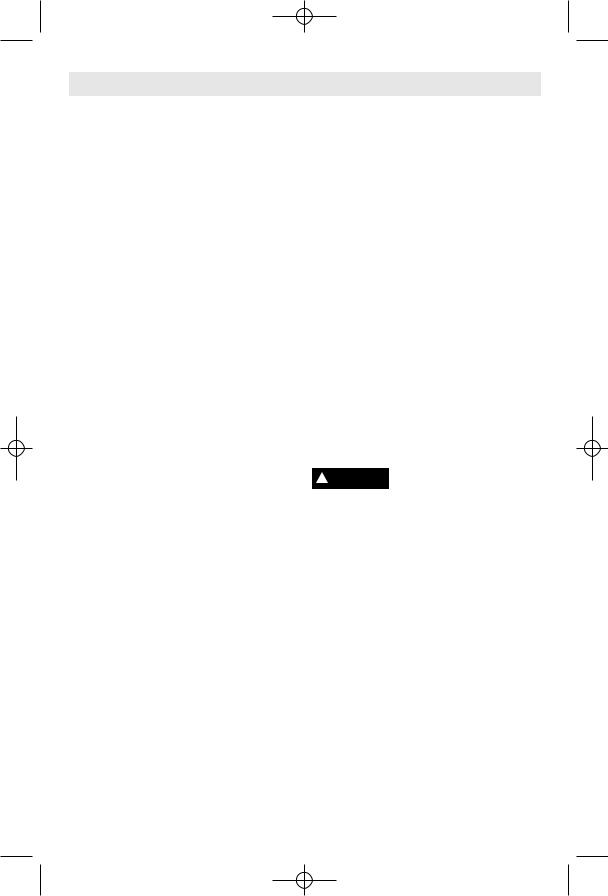
BM 2609140575 07-08 7/8/08 3:54 PM Page 4
Safety Rules for Oscillating Tools
Hold power tools by insulated gripping surfaces when performing an operation where the cutting tools may contact hidden wiring. Contact with a "live" wire will make exposed metal parts of the tool "live" and shock the operator. Do not drill, fasten or break into existing walls or other blind areas where electrical wiring may exist. If this situation is unavoidable, disconnect all fuses or circuit breakers feeding this worksite.
Use a metal detector to determine if there are gas or water pipes hidden in the work area or call the local utility company for assistance before beginning the operation.
Striking or cutting into a gas line will result in explosion. Water entering an electrical device may cause electrocution.
Always hold the tool firmly with both hands for maximum control. Keep proper footing and balance at all times. This enables better control of the power tool in unexpected situations.
Keep hands away from cutting area. Do not reach under the material being cut. The proximity of the blade to your hand is hidden from your sight.
Do not use dull or damaged blades. Bent blade can break easily or cause kickback.
Exercise extreme caution when handling the accessories. The accessories are very sharp.
Wear protective gloves when changing cutting accessories. Accessories become hot after prolonged usage.
Use thick cushioned gloves and limit the exposure time by taking frequent rest periods. Vibration caused by the tool may be harmful to the hands and arms.
Before scraping, check workpiece for nails. If there are nails, either remove them or set them well below intended finished surface.
Striking a nail with accessory edge could cause the tool to jump.
Do not wet sand with this tool. Liquids entering the motor housing is an electrical shock hazard.
Never work in area which is soaked with a liquid, such as a solvent or water, or
dampened such as newly applied wallpaper. There is an electrical shock hazard when working in such conditions with a power tool and heating of the liquid caused by scraping action may cause harmful vapors to be emitted from workpiece.
Always wear eye protection and a dust mask for dusty applications and when sanding overhead. Sanding particles can be absorbed by your eyes and inhaled easily and may cause health complications.
Use special precautions when sanding chemically pressure treated lumber, paint that may be lead based, or any other materials that may contain carcinogens. A suitable breathing respirator and protective clothing must be worn by all persons entering the work area. Work area should be sealed by plastic sheeting and persons not protected should be kept out until work area is thoroughly cleaned.
Do not use sandpaper intended for larger sanding pads. Larger sandpaper will extend beyond the sanding pad causing snagging, tearing of the paper or kick-back. Extra paper extending beyond the sanding pad can also cause serious lacerations.
! WARNING Some dust created by power sanding, sawing,
grinding, drilling, and other construction activities contains chemicals known to cause cancer, birth defects or other reproductive harm. Some examples of these chemicals are:
•Lead from lead-based paints,
•Crystalline silica from bricks and cement and other masonry products, and
•Arsenic and chromium from chemicallytreated lumber.
Your risk from these exposures varies, depending on how often you do this type of work. To reduce your exposure to these chemicals: work in a well ventilated area, and work with approved safety equipment, such as those dust masks that are specially designed to filter out microscopic particles.
-4-
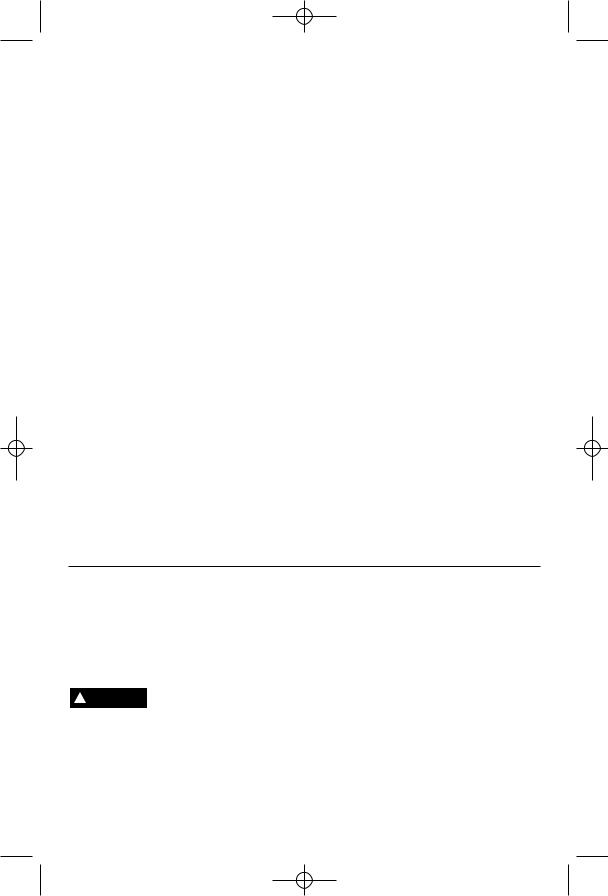
BM 2609140575 07-08 7/8/08 3:54 PM Page 5
Battery/Charger
Before using battery charger, read all instructions and cautionary markings on
(1) battery charger, (2) battery pack, and (3) product using battery.
Use only the charger which accompanied your product or direct replacement as listed in the catalog or this manual. Do not substitute any other charger. Use only Bosch approved chargers with your product. See Functional Description and Specifications.
Do not disassemble charger or operate the charger if it has received a sharp blow, been dropped or otherwise damaged in any way. Replace damaged cord or plugs immediately. Incorrect reassembly or damage may result in electric shock or fire.
Do not recharge battery in damp or wet environment. Do not expose charger to rain or snow. If battery case is cracked or otherwise damaged, do not insert into charger. Battery short or fire may result.
Charge only Bosch approved rechargeable batteries. See Functional Description and Specifications. Other types of batteries may burst causing personal injury and damage.
Charge battery pack in temperatures above +32 degrees F (0 degrees C) and below
+113 degrees F (45 degrees C). Store tool and battery pack in locations where temperatures will not exceed 120 degrees F (49 degrees C). This is important to prevent serious damage to the battery cells.
Battery leakage may occur under extreme usage or temperature conditions. Avoid contact with skin and eyes. The battery liquid is caustic and could cause chemical burns to tissues. If liquid comes in contact with skin, wash quickly with soap and water. If the liquid contacts your eyes, flush them with water for a minimum of 10 minutes and seek medical attention.
Place charger on flat non-flammable surfaces and away from flammable materials when re-charging battery pack.
The charger and battery pack heat during charging. Carpeting and other heat insulating surfaces block proper air circulation which may cause overheating of the charger and battery pack. If smoke or melting of the case are observed unplug the charger immediately and do not use the battery pack or charger.
Use of an attachment not recommended or sold by Bosch may result in a risk of fire, electric shock or injury to persons.
Battery Care
! WARNING When batteries are not in tool or charger, keep them
away from metal objects. For example, to protect terminals from shorting DO NOT place batteries in a tool box or pocket with
nails, screws, keys, etc. Fire or injury may result.
DO NOT PUT BATTERIES INTO FIRE OR EXPOSE TO HIGH HEAT. They may explode.
-5-
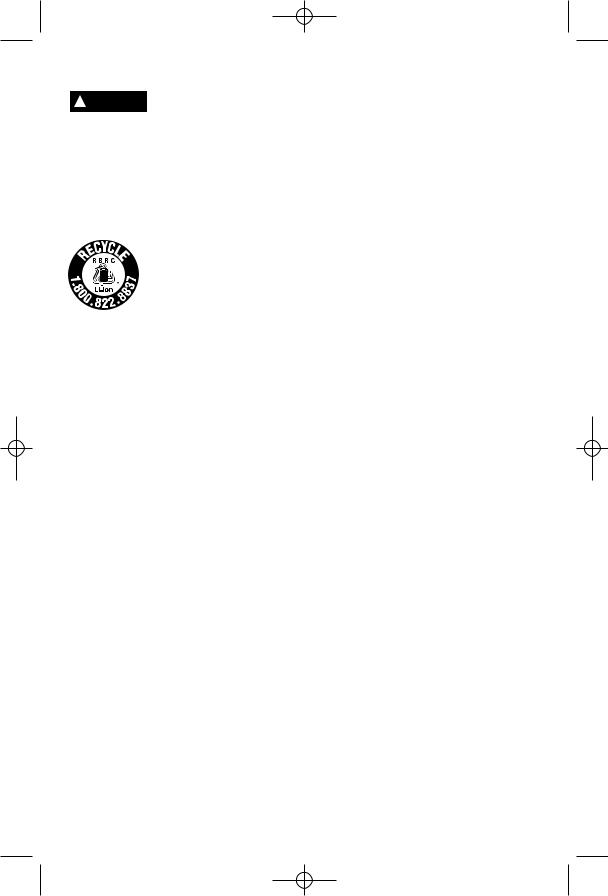
BM 2609140575 07-08 7/8/08 3:54 PM Page 6
Battery Disposal
! WARNING Do not attempt to disassemble the battery or
remove any component projecting from the battery terminals. Fire or injury may result. Prior to disposal, protect exposed terminals with heavy insulating tape to prevent shorting.
LITHIUM-ION BATTERIES
If equipped with a lithium-ion battery, the battery must be collected, recycled or disposed of in an environmentally sound manner.
“The EPA certified RBRC Battery Recycling Seal on the lithium-ion (Li-ion) battery indicates Robert Bosch Tool Corporation is voluntarily participating in an industry
program to collect and recycle these batteries at the end of their useful life, when taken out of service in the United States or Canada. The RBRC program provides a convenient alterative to placing used Li-ion batteries into the trash or the municipal waste stream, which may be illegal in your area.
Please call 1-800-8-BATTERY for information on Li-ion battery recycling and disposal bans/restrictions in your area, or return your batteries to a Skil/Bosch/Dremel Service Center for recycling. Robert Bosch Tool Corporation’s involvement in this program is part of our commitment to preserving our environment and conserving our natural resources.”
-6-
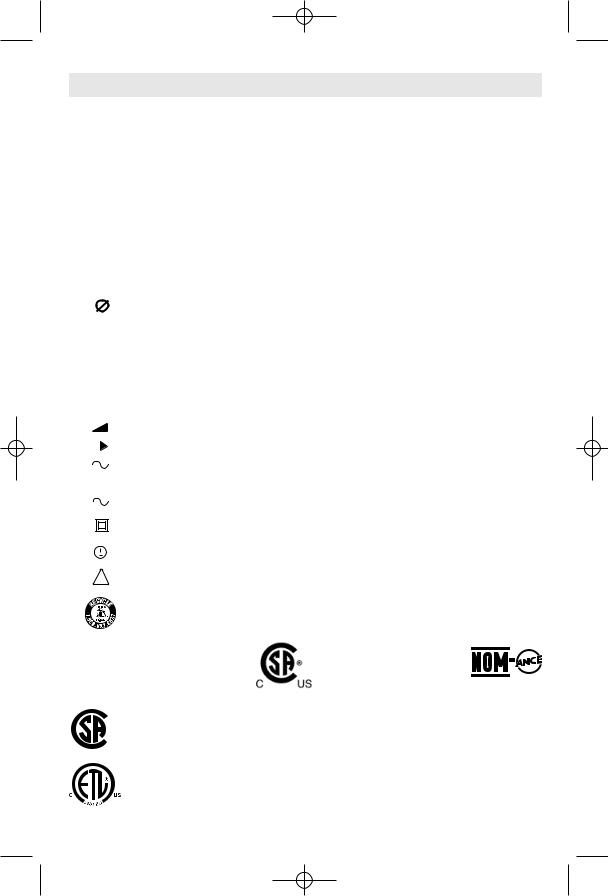
BM 2609140575 07-08 7/8/08 3:54 PM Page 7
Symbols
IMPORTANT: Some of the following symbols may be used on your tool. Please study them and learn their meaning. Proper interpretation of these symbols will allow you to operate the tool better and safer.
Symbol |
Name |
Designation/Explanation |
||||||||
|
|
V |
Volts |
Voltage (potential) |
||||||
|
|
|
|
|
|
|
|
|
|
|
|
|
A |
Amperes |
Current |
||||||
|
|
|
|
|
|
|
|
|
|
|
|
Hz |
Hertz |
Frequency (cycles per second) |
|||||||
|
|
|
|
|
|
|
|
|
|
|
|
W |
Watt |
Power |
|||||||
|
|
|
|
|
|
|
|
|
|
|
|
kg |
Kilograms |
Weight |
|||||||
min |
Minutes |
Time |
||||||||
|
|
|
|
|
|
|
|
|
|
|
|
|
|
s |
Seconds |
Time |
|||||
|
|
|
|
|
|
|
|
|
Diameter |
Size of drill bits, grinding wheels, etc. |
|
|
|
|
|
|
|
|
|
|
|
|
n0 |
No load speed |
Rotational speed, at no load |
|||||||
.../min |
Revolutions or reciprocation per minute |
Revolutions, strokes, surface speed, |
||||||||
|
|
|
|
|
|
|
|
|
|
orbits etc. per minute |
|
|
|
|
|
|
|
|
|
|
|
0 |
|
|
|
Off position |
Zero speed, zero torque... |
|||||
|
|
|
|
|
|
|
|
|
|
|
1, 2, 3, ... |
Selector settings |
Speed, torque or position settings. |
||||||||
I, II, III, |
|
Higher number means greater speed |
||||||||
|
|
|
|
|
|
|
|
|
|
|
0 |
|
|
|
|
|
|
|
Infinitely variable selector with off |
Speed is increasing from 0 setting |
|
|
|
|
|
|
|
|
|
|
|
|
|
|
|
|
|
|
|
|
|
Arrow |
Action in the direction of arrow |
|
|
|
|
|
|
|
|
|
||
|
|
|
|
|
|
|
|
|
|
|
|
|
|
|
|
|
|
|
|
Alternating current |
Type or a characteristic of current |
|
|
|
|
|
|
|
|
|
|
|
|
|
|
|
|
|
|
|
|
Direct current |
Type or a characteristic of current |
|
|
|
|
|
|
|
|
|
||
|
|
|
|
|
|
|
|
|
Alternating or direct current |
Type or a characteristic of current |
|
|
|
|
|
|
|
|
|
||
|
|
|
|
|
|
|
|
|
|
|
|
|
|
|
|
|
|
|
|
Class II construction |
Designates Double Insulated |
|
|
|
|
|
|
|
|
|
||
|
|
|
|
|
|
|
|
|
|
Construction tools. |
|
|
|
|
|
|
|
|
|
|
|
|
|
|
|
|
|
|
|
|
|
|
|
|
|
|
|
|
|
|
|
Earthing terminal |
Grounding terminal |
|
|
|
|
|
|
|
|
|
||
|
|
|
|
|
|
|
|
|
|
|
|
|
|
|
|
|
|
|
|
Warning symbol |
Alerts user to warning messages |
|
|
|
|
|
|
|
|
|
|
|
|
|
|
|
|
|
|
|
|
Li-ion RBRC seal |
Designates Li-ion battery recycling |
|
|
|
|
|
|
|
|
|
|
program |
|
|
|
|
|
|
|
|
|
|
|
This symbol designates that this tool is listed by Underwriters Laboratories.
This symbol designates that this tool is listed by the Canadian Standards Association.
This symbol designates that this tool is listed by the Canadian Standards Association, to United States and Canadian Standards.
This symbol designates that this tool is listed by Underwriters Laboratories, to United States and Canadian Standards.
This symbol designates that this tool is listed by the Intertek Testing Services, to United States and Canadian Standards.
This symbol designates that
this tool complies to NOM Mexican Standards.
-7-
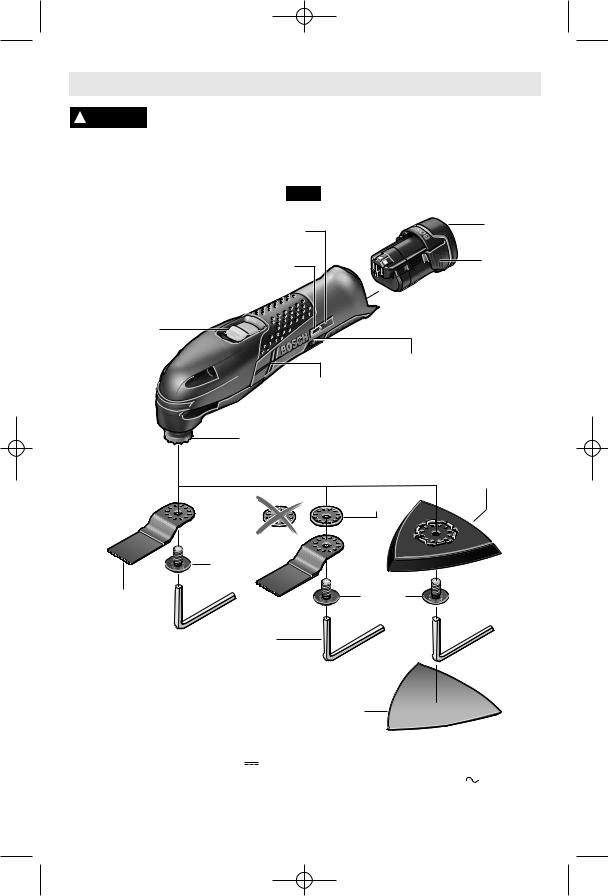
BM 2609140575 07-08 7/8/08 3:54 PM Page 8
Functional Description and Specifications
Disconnect battery pack from tool or place the switch in the locked or off ! WARNING position before making any assembly, adjustments or changing
accessories. Such preventive safety measures reduce the risk of starting the tool accidentally.
Multi-X Cordless Oscillating Tool
|
|
FIG. 1 |
|
|
|
|
CHARGE CONDITION |
|
BATTERY |
||
|
|
PACK |
|||
|
INDICATOR BUTTON |
|
BATTERY |
||
|
|
|
|
|
|
|
BATTERY CHARGE CONDITION |
|
|
RELEASE |
|
|
|
|
TABS |
||
|
INDICATOR LIGHTS |
|
|
||
|
|
|
|
||
SLIDE "ON/OFF" |
|
|
|
|
|
SWITCH |
|
|
|
|
|
|
|
|
|
VARIABLE |
|
|
|
VENTILATION |
SPEED DIAL |
|
|
|
|
|
|
||
|
|
|
OPENINGS |
|
|
|
ACCESSORY |
|
|
|
|
|
|
HOLDER |
|
|
|
|
|
|
|
|
RUBBER |
|
|
|
|
BACKING PAD |
|
|
|
|
ADAPTER |
|
|
|
HEX |
|
|
|
|
|
BOLT |
|
|
|
|
PLUNGE CUT |
|
|
HEX BOLT |
|
|
BLADE |
|
|
|
|
|
|
|
5 MM |
|
|
|
|
HEX WRENCH |
|
|
|
|
|
|
|
SANDING SHEET |
|
|
Model number |
PS50 |
|
Battery pack |
BAT411 |
|
Voltage rating |
10.8V/12V |
MAX |
Charger |
BC430 |
|
No load speed |
n0 20,000/min |
Voltage rating |
120 V |
60 Hz |
|
Charge time |
30 minutes |
|
|
|
|
-8-
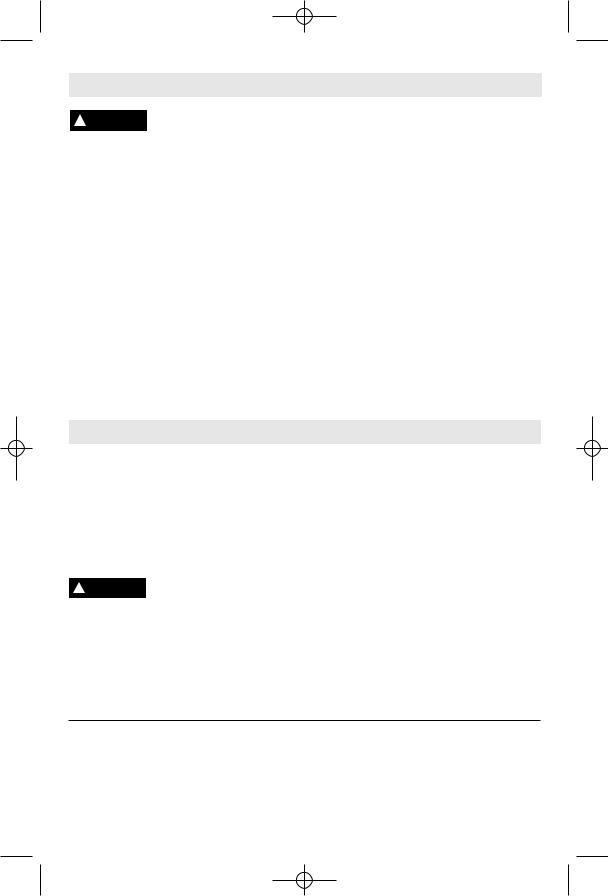
BM 2609140575 07-08 7/8/08 3:54 PM Page 9
Assembly
Disconnect battery pack ! WARNING from tool or place the switch
in the locked or off position before making any assembly, adjustments or changing accessories. Such preventive safety measures reduce the risk of starting the tool accidentally.
INSTALLING AND REMOVING
ACCESSORIES
1. To install accessories, align holes in accessory with locating pins on accessory holder in desired position. Assure that pin in holder are engaged into holes in accessory and securely tighten with with hex bolt provided (Fig. 1).
Your accessories can be engaged into accessory holder 12 positions 30 degrees apart.
For intermediate position an adapter is provided that will allow you to attach the accessory in any position. Use of adapter will
also allow you to use most competitor accessories.
2. To remove accessory, loosen and remove hex bolt and remove accessory from holder (Fig. 1).
INSTALLING SANDING SHEETS
Your tool uses hook-and-loop backed sandpaper, which firmly grips the backing pad when applied with moderate pressure.
To change, merely peel off the old sandpaper, remove dust from the backing pad if necessary, and press the new sandpaper in place (Fig. 1).
After considerable use the backing pad surface will become worn, and the backing pad must be replaced when it no longer offers a firm grip. If you are experiencing premature wear of the backing pad facing, decrease the amount of pressure you are applying during operation of the tool.
Operating Instructions
SLIDE "ON/OFF" SWITCH
The tool is switched "ON" by the slide switch located on the topside of the motor housing (Fig. 1).
TO TURN THE TOOL "ON" slide the switch button forward to the “I” .
TO TURN THE TOOL "OFF" slide the switch button backward the “0” .
! WARNING |
Hold the tool with both hands |
|
while starting the tool, since |
torque from the motor can cause the tool to twist.
VARIABLE SPEED DIAL
This tool is equipped with a variable speed dial. The speed may be controlled during operation by presetting the dial in any one of six positions (Fig. 1).
BATTERY CHARGE CONDITION
INDICATOR LIGHTS
Your tool is equipped with charge condition indicator lights (Fig. 1). The indicator lights shows the charge condition of the battery during operation.
For safety reasons, only check the charge condition when the tool is at a complete standstill.
To check the charge condition, press and hold the charge condition indicator button with the tool in the off position.
LED |
Capacity |
Continuous lighting 3 x green |
2/3 |
Continuous lighting 2 x green |
1/3 |
Continuous lighting 1 x green |
1/3 |
Flashing light 1 x green |
reserve |
|
|
APPLICATION
Your tool is intended for sawing and separating wooden materials, plastic, plaster, non-ferrous metals and fasteners (e.g. nails and clamps)
as well as for working on soft wall tiles and for dry sanding and scraping of small surfaces. It is especially suitable for working close to edges and for flush cutting.
-9-
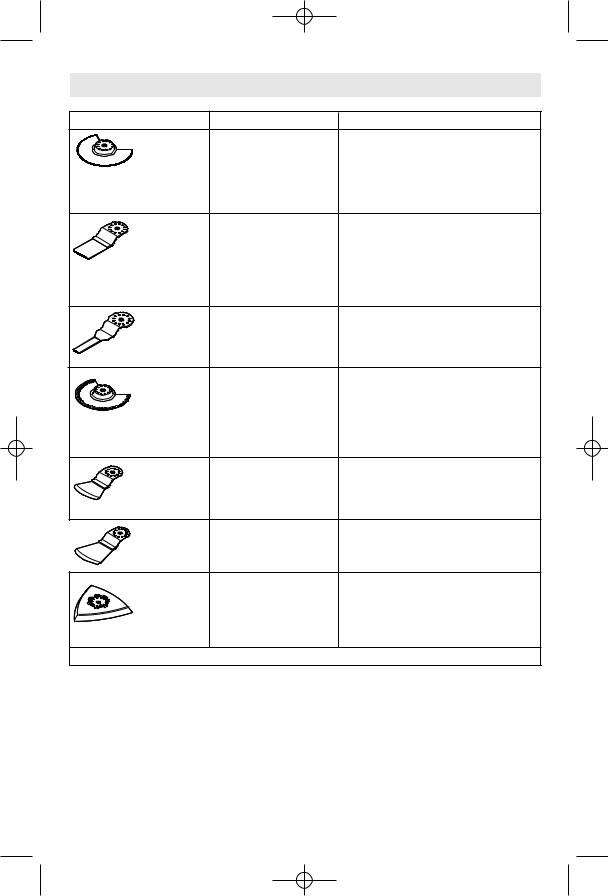
BM 2609140575 07-08 7/8/08 3:54 PM Page 10
Selecting Accessories
Accessory |
Material |
Application |
BIM segment |
Hard and soft wood, |
Separating and plunge cuts; also for |
saw blade |
plastic, non-ferrous |
sawing close to edges, in corners and |
|
metals |
hard to reach areas; |
|
|
Example: shortening already installed |
|
|
bottom rails or door hinges, plunge |
|
|
cuts for adjusting floor panels. |
HCS plunge |
Wooden materials, |
Separating and deep plunge cuts; also |
cut saw |
plastic, gypsum and |
for sawing close to edges, in corners |
blade |
other soft materials |
and hard to reach areas; |
|
|
Example: Sawing off water pipes |
|
|
(PVC) or cable ducts flush against |
|
|
walls, floors or ceilings. |
BIM plunge |
Hard and soft wood, |
Smaller separating and plunge cuts; |
cut saw |
metal (e.g., nails, |
Example: Shortening narrow profiles, |
blade |
screws, small profiles), |
cutting fastening elements such as |
|
non ferrous metals |
staples and nails. |
HM-Riff |
Grouting joints, soft |
Cutting and separating close to edges, |
Segmented |
wall tiles, glass-fibre |
in corners or hard to reach areas; |
saw blade |
reinforced plastic and |
Example: Removing grouting joints |
|
other abrasive |
between wall tiles for repair work, |
|
materials |
cutting openings in tiles, gypsum |
|
|
boards or plastic. |
Rigid scraper |
Wooden materials, |
Scraping off old coats of varnish or |
|
plastic, gypsum and |
other adhesive, removing bonded |
|
other soft materials |
carpeting, e.g., on stairs/steps or other |
|
|
small/medium-sized surfaces. |
Flexible |
Silicone and other |
Removal of putty or other softer |
scraper |
elastic materials |
residue from confined areas. |
Base plate |
Depends on sanding |
Sanding surfaces close to edges, in |
for sanding |
sheet |
corners or hard to reach areas; |
|
|
Depending on the sanding sheet for, |
|
|
e.g., sanding wood, paint, varnish, |
|
|
stone, glass. |
Optional Accessories
-10-

BM 2609140575 07-08 7/8/08 3:54 PM Page 11
Operating Tips
Depending on the accessory used, your tool is suitable for work that arises during renovation of new buildings, cleaning of new buildings as well as for hobby carving.
Below are some typical uses for your Oscillating Multi Tool.
Removal work
e.g. carpets & backing, old tile adhesives, caulking on masonry, wood and other surfaces.
Cleaning work
e.g. cleaning of tiles, wood surfaces, skis etc.
Removal of excess materials
e.g. plaster, mortar splatters, concrete on tiles, sills.
Preparation of surfaces e.g. for new floors and tiles.
Detail sanding
e.g. for sanding in extremely tight areas, such as louvered panels, crafts, otherwise difficult to reach and require hand sanding
SCRAPING
Scrapers are suitable for removing old coats of varnish or adhesives, removing bonded carpeting, e.g. on stairs/steps and other small/medium size surfaces.
Wide scrapers are for large area removal, narrow for use in hard-to-reach areas.
Select a medium to high speed.
Turn the tool on and place desired accessory on the area where material is to be removed.
Begin with a flat angle and light pressure. The stroke motion of accessory only occurs when pressure is applied to the material to be removed.
Excessive pressure can gouge or damage the background surfaces (e.g,. wood, plaster).
Work with the accessory away from the body. Never position hand near or directly in front of working area. Always hold the tool with both hands and wear protective gloves.
SANDING
Sanding accessories are suitable for dry sanding of wood, metal, smaller surfaces, corners and edges and hard to reach areas.
Profiles and grooves may be finished using the tip or edge of the selected accessory, which should occasionally be rotated during use to distribute the wear on the accessory and backing pad surface.
Always be certain that smaller workpieces are securely fastened to a bench or other support. Larger panels may be held in place by hand on a bench or sawhorses.
SANDING: Open-coat aluminum oxide sanding sheets are recommended for most wood or metal sanding applications, as this synthetic material cuts quickly and wears well. Some applications, such as metal finishing or cleaning, require special abrasive pads which are available from your dealer. For best results, use Bosch sanding and polishing accessories which are of superior quality and are carefully selected to produce professional quality results with your tool.
The following suggestions may be used as a general guide for abrasive selection, but the best results will be obtained by sanding a test sample of the workpiece first.
Grit |
Application |
Coarse |
For rough wood or metal |
|
sanding, and rust or old |
|
finish removal. |
Medium |
For general wood or metal |
|
sanding |
Fine |
For final finishing of wood, |
|
metal, plaster and other |
|
surfaces. |
Extra fine |
For final sanding of bare |
|
wood, smoothing old paint, |
|
or preparing a finished |
|
surface for recoating. |
With the workpiece firmly secured, turn tool on as described above. Contact the work with the tool after the tool has reached its full speed, and remove it from the work before switching the tool off. Operating your tool in this manner will prolong switch and motor life, and greatly increase the quality of your work.
Move the tool in long steady strokes parallel to the grain using some lateral motion to overlap the strokes by as much as 75%. DO NOT apply excessive pressure - let the tool do the work. Excessive pressure will result in poor handling, vibration, and unwanted sanding marks.
SAWING
Sawing accessories are suitable for sawing thin sheet steel, wood and plastics.
Select a high oscillating speed.
-11-
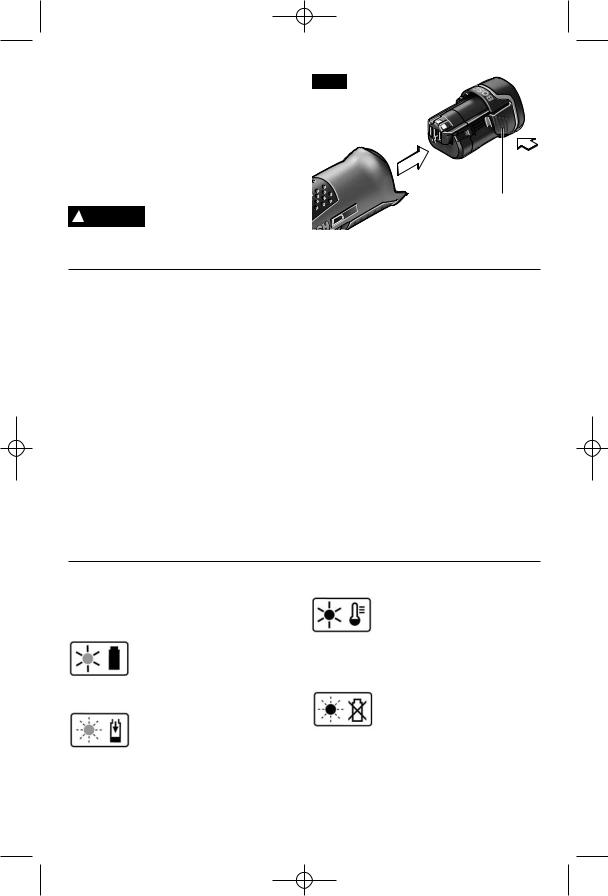
BM 2609140575 07-08 7/8/08 3:54 PM Page 12
FIG. 2
INSERTING AND RELEASING
BATTERY PACK
Release battery pack from tool by pressing on both sides of the battery release tabs and pull downward (Fig. 2).
To insert battery, align battery and slide battery pack into tool until it locks into position. Do not force.
! WARNING If battery release tabs are cracked or otherwise
damaged, do not insert into tool. Battery can fall out during operation.
BATTERY
RELEASE TABS
IMPORTANT CHARGING NOTES
1.The charger was designed to fast charge the battery only when the battery temperature is between 32˚F (0˚C) and 113˚F (45˚C). If the battery pack is too hot or too cold, the charger will not fast charge the battery. (This may happen if the battery pack is hot from heavy use). When the battery temperature returns to between 32˚F (0˚C) and 113˚F (45˚C), the charger will automatically begin charging.
2.A substantial drop in operating time per charge may mean that the battery pack is nearing the end of its life and should be replaced.
3.Remember to unplug charger during storage period.
4.If battery does not charge properly:
a.Check for voltage at outlet by plugging in some other electrical device.
b.Check to see if outlet is connected to a light switch which turns power “off” when lights are turned off.
c.Check battery pack terminals for dirt. Clean with cotton swab and alcohol if necessary.
d.If you still do not get proper charging, take or send tool, battery pack and charger to your local Bosch Service Center. See “Tools, Electric” in the Yellow Pages for names and addresses.
Note: Use of chargers or battery packs not sold by Bosch will void the warranty.
CHARGER INDICATORS, SYMBOLS AND MEANING
If the indicator lights are “OFF”, the charger is not receiving power from power supply outlet.
If the green indicator light is “ON”, the charger is plugged in but the battery pack is not
inserted, or the battery pack is fully charged and is being trickle charged.
If the green indicator light is “BLINKING”, the battery pack is being fast-charged. Fast-
charging will automatically stop when the battery pack is fully charged.
If the red indicator light is “ON”, the battery pack is too hot or cold for fast-charging. The
charger will switch to trickle charge, until a suitable temperature is reached, at which time the charger will switch automatically to fast-charging.
If the red indicator light is “BLINKING”, the battery pack cannot accept a charge or the
contacts of the charger or battery pack are contaminated. Clean the contacts of the charger or battery pack only as directed in these operating instructions or those supplied with your tool or battery pack.
-12-
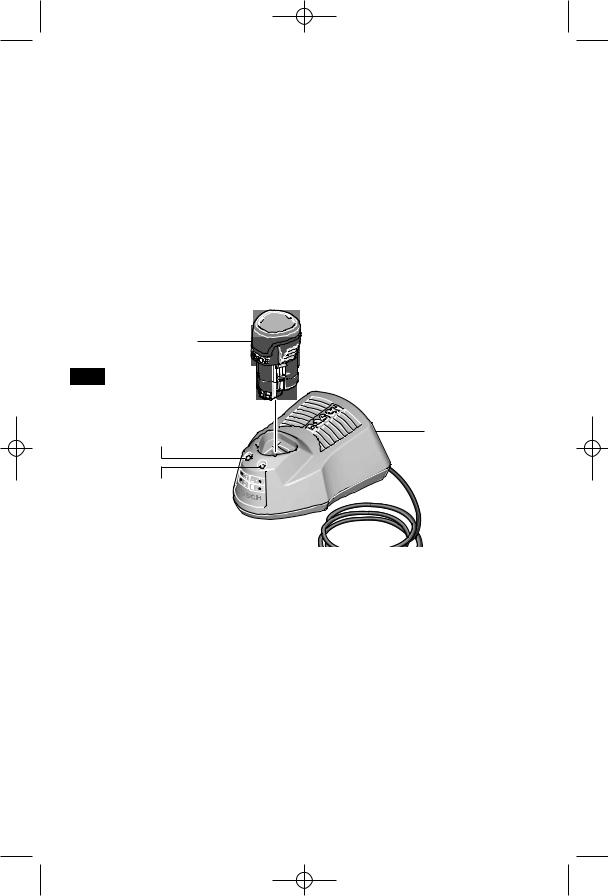
BM 2609140575 07-08 7/8/08 3:54 PM Page 13
CHARGING BATTERY PACK (BC430 30 MINUTE CHARGER)
Plug charger cord into your standard power outlet, then insert battery pack into charger (Fig. 3).
The charger’s green indicator light will begin to “BLINK”. This indicates that the battery is receiving a fast charge. Fast-charging will automatically stop when the battery pack is fully charged.
When the indicator light stops “BLINKING” (and becomes a steady green light) fast charging is complete.
The battery pack may be used even though the light may still be blinking. The light may require more time to stop blinking depending on temperature. When you begin the
charging process of the battery pack, a steady red light could also mean the battery pack is too hot or too cold.
The purpose of the green light is to indicate that the battery pack is fast-charging. It does not indicate the exact point of full charge. The light will stop blinking in less time if the battery pack was not completely discharged.
When charging several batteries in sequence, the charge time may slightly increase.
When the battery pack is fully charged, unplug the charger (unless you're charging another battery pack) and slip the battery pack back into the tool.
BATTERY
PACK
FIG. 3
CHARGER
RED LIGHT
GREEN LIGHT
-13-

BM 2609140575 07-08 7/8/08 3:54 PM Page 14
Maintenance
Service
! NO USER SERVICE-ABLE WARNING PARTS INSIDE. Preventive
maintenance performed by unauthorized personnel may result in misplacing of internal wires and components which could cause serious hazard. We recommend that all tool service be performed by a Bosch Factory Service Center or Authorized Bosch Service Station. SERVICEMEN: Disconnect tool and/or charger from power source before servicing.
BATTERIES
Be alert for battery packs that are nearing their end of life. If you notice decreased tool performance or significantly shorter running time between charges then it is time to replace the battery pack. Failure to do so can cause the tool to operate improperly or damage the charger.
TOOL LUBRICATION
Your Bosch tool has been properly lubricated and is ready for use.
D.C. MOTORS
The motor in your tool has been engineered for many hours of dependable service. To maintain peak efficiency of the motor, we recommend it be examined every six months. Only a genuine Bosch replacement motor specially designed for your tool should be used.
Cleaning
To avoid accidents, always ! WARNING disconnect the tool and/or
charger from the power supply before cleaning. The tool may be cleaned most effectively with compressed dry air. Always wear safety goggles when cleaning tools with compressed air.
Ventilation openings and switch levers must be kept clean and free of foreign matter. Do not attempt to clean by inserting pointed objects through opening.
Certain cleaning agents and ! CAUTION solvents damage plastic
parts. Some of these are: gasoline, carbon tetrachloride, chlorinated cleaning solvents, ammonia and household detergents that contain ammonia.
Accessories
! WARNING If an extension cord is necessary, a cord with
adequate size conductors that is capable of carrying the current necessary for your tool must be used. This will prevent excessive voltage drop, loss of power or overheating. Grounded tools must use 3-wire extension cords that have 3-prong plugs and receptacles.
NOTE: The smaller the gauge number, the heavier the cord.
RECOMMENDED SIZES OF EXTENSION CORDS 120 VOLT ALTERNATING CURRENT TOOLS
Tool’s |
Cord Size in A.W.G. |
Wire Sizes in mm2 |
|||||||
|
|
|
|
|
|
|
|
||
Ampere |
|
|
|
|
|
|
|
|
|
Cord Length in Feet |
Cord Length in Meters |
||||||||
Rating |
|||||||||
25 |
50 |
100 |
150 |
15 |
30 |
60 |
120 |
||
|
|||||||||
3-6 |
|
|
|
|
|
|
|
|
|
18 |
16 |
16 |
14 |
0.75 |
0.75 |
1.5 |
2.5 |
||
6-8 |
18 |
16 |
14 |
12 |
0.75 |
1.0 |
2.5 |
4.0 |
|
8-10 |
18 |
16 |
14 |
12 |
0.75 |
1.0 |
2.5 |
4.0 |
|
10-12 |
16 |
16 |
14 |
12 |
1.0 |
2.5 |
4.0 |
— |
|
12-16 |
14 |
12 |
— |
— |
— |
— |
— |
— |
|
|
|
|
|
|
|
|
|
|
|
-14-
